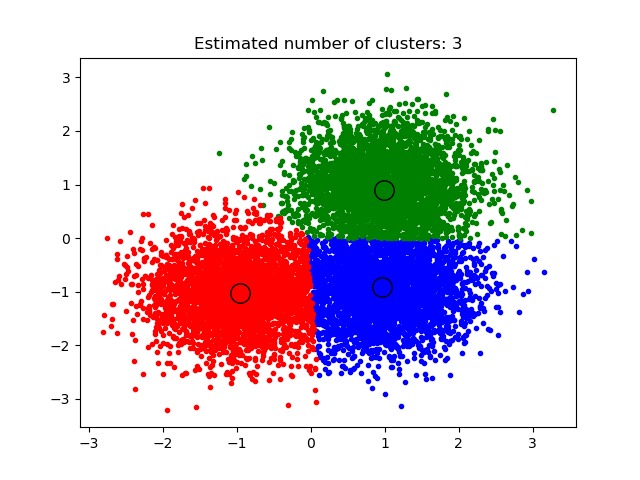mean-shift聚类算法演示简介
Mean Shift算法,又被称为均值漂移算法。与K-Means算法一样,都是基于聚类中心的聚类算法,不同的是, Mean Shift算法不需要事先制定类别个数k。
参考:
Dorin Comaniciu和Peter Meer,“均值变换:一种用于特征空间分析的可靠方法”。
(Dorin Comaniciu and Peter Meer, “Mean Shift: A robust approach toward feature space analysis”. IEEE Transactions on Pattern Analysis and Machine Intelligence. 2002. pp. 603-619.)
代码实现[Python]
# -*- coding: utf-8 -*-
print(__doc__)
import numpy as np
from sklearn.cluster import MeanShift, estimate_bandwidth
from sklearn.datasets.samples_generator import make_blobs
# #############################################################################
# 生成样本数据
centers = [[1, 1], [-1, -1], [1, -1]]
X, _ = make_blobs(n_samples=10000, centers=centers, cluster_std=0.6)
# #############################################################################
# 使用MeanShift聚类
# The following bandwidth can be automatically detected using
bandwidth = estimate_bandwidth(X, quantile=0.2, n_samples=500)
ms = MeanShift(bandwidth=bandwidth, bin_seeding=True)
ms.fit(X)
labels = ms.labels_
cluster_centers = ms.cluster_centers_
labels_unique = np.unique(labels)
n_clusters_ = len(labels_unique)
print("number of estimated clusters : %d" % n_clusters_)
# #############################################################################
# 绘制结果
import matplotlib.pyplot as plt
from itertools import cycle
plt.figure(1)
plt.clf()
colors = cycle('bgrcmykbgrcmykbgrcmykbgrcmyk')
for k, col in zip(range(n_clusters_), colors):
my_members = labels == k
cluster_center = cluster_centers[k]
plt.plot(X[my_members, 0], X[my_members, 1], col + '.')
plt.plot(cluster_center[0], cluster_center[1], 'o', markerfacecolor=col,
markeredgecolor='k', markersize=14)
plt.title('Estimated number of clusters: %d' % n_clusters_)
plt.show()
代码执行
代码运行时间大约:0分0.397秒。
运行代码输出的文本内容如下:
number of estimated clusters : 3
运行代码输出的图片内容如下:

源码下载
- Python版源码文件: plot_mean_shift.py
- Jupyter Notebook版源码文件: plot_mean_shift.ipynb
